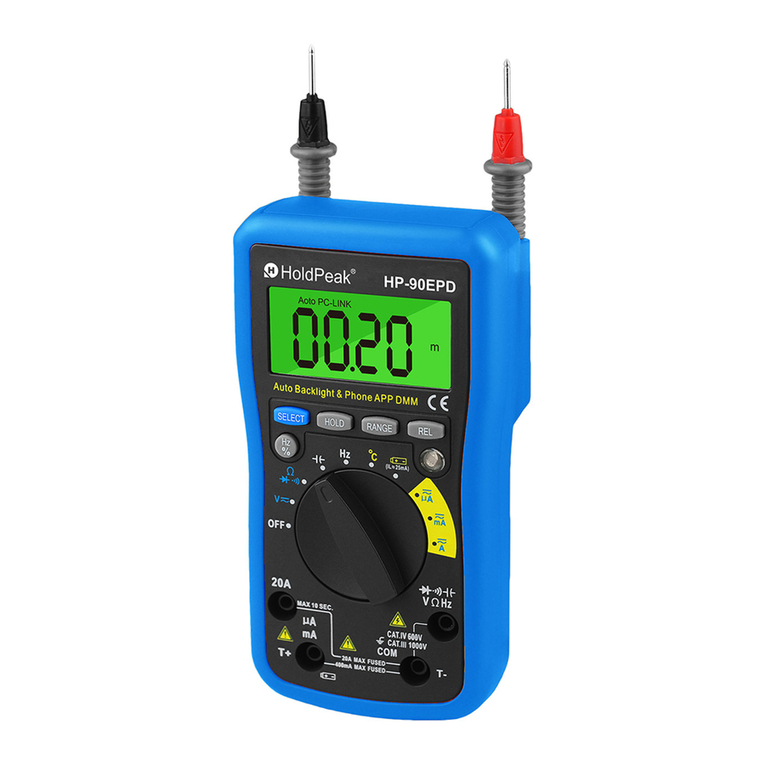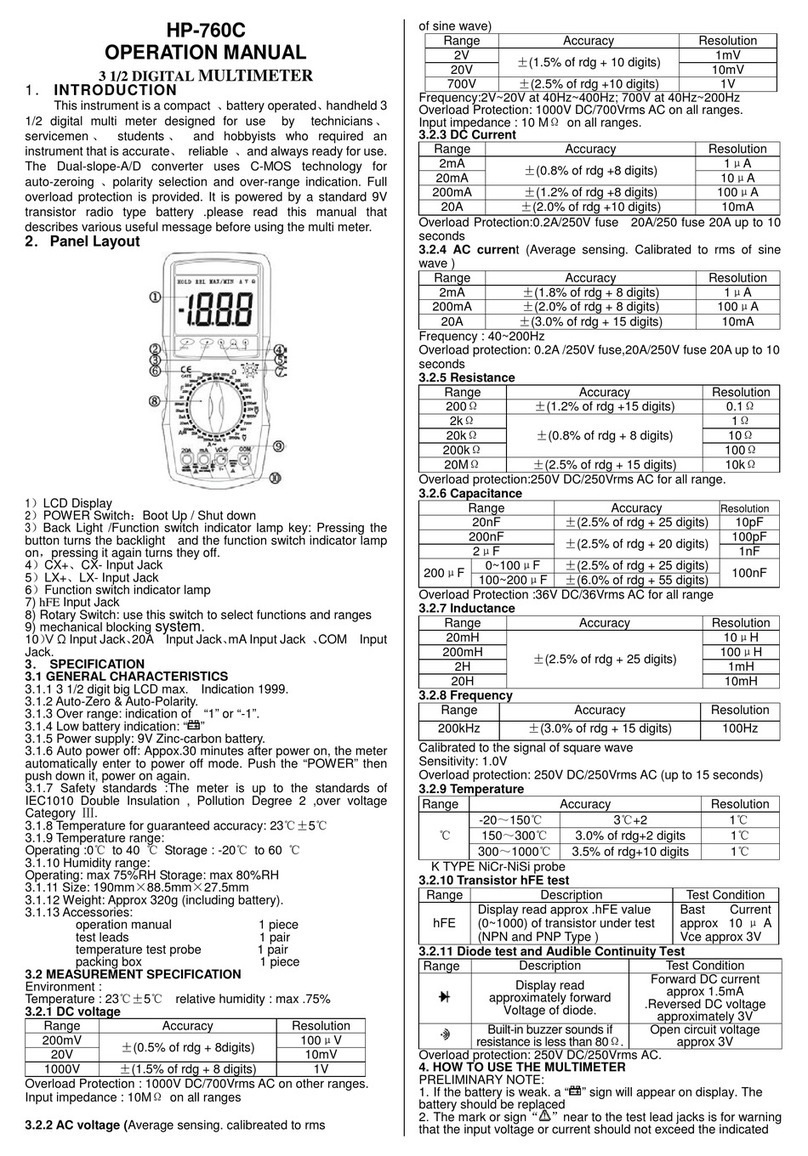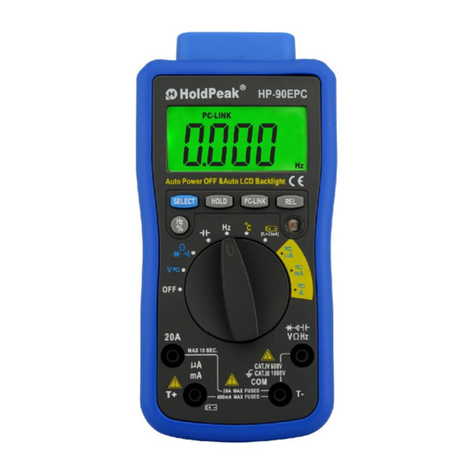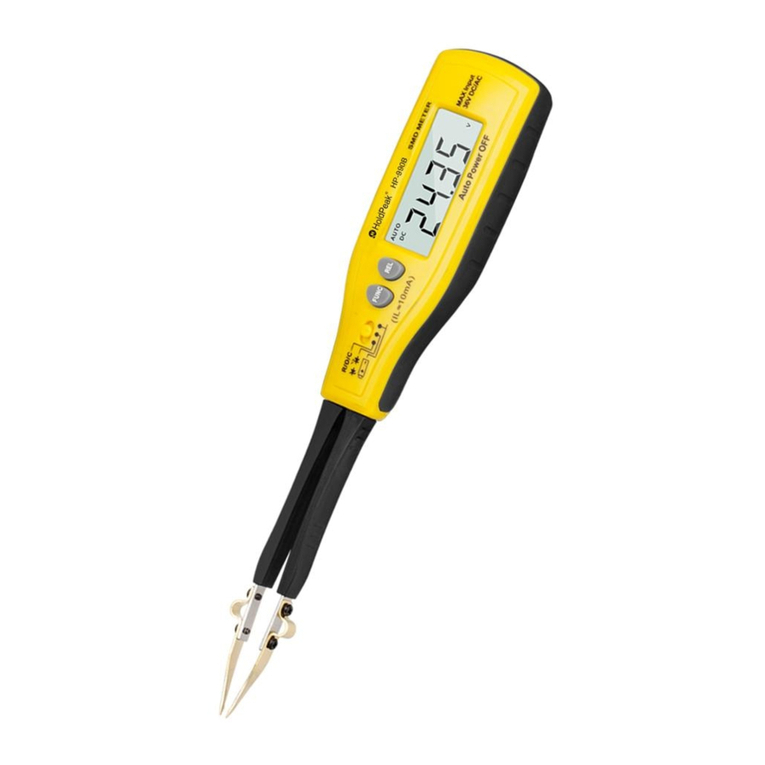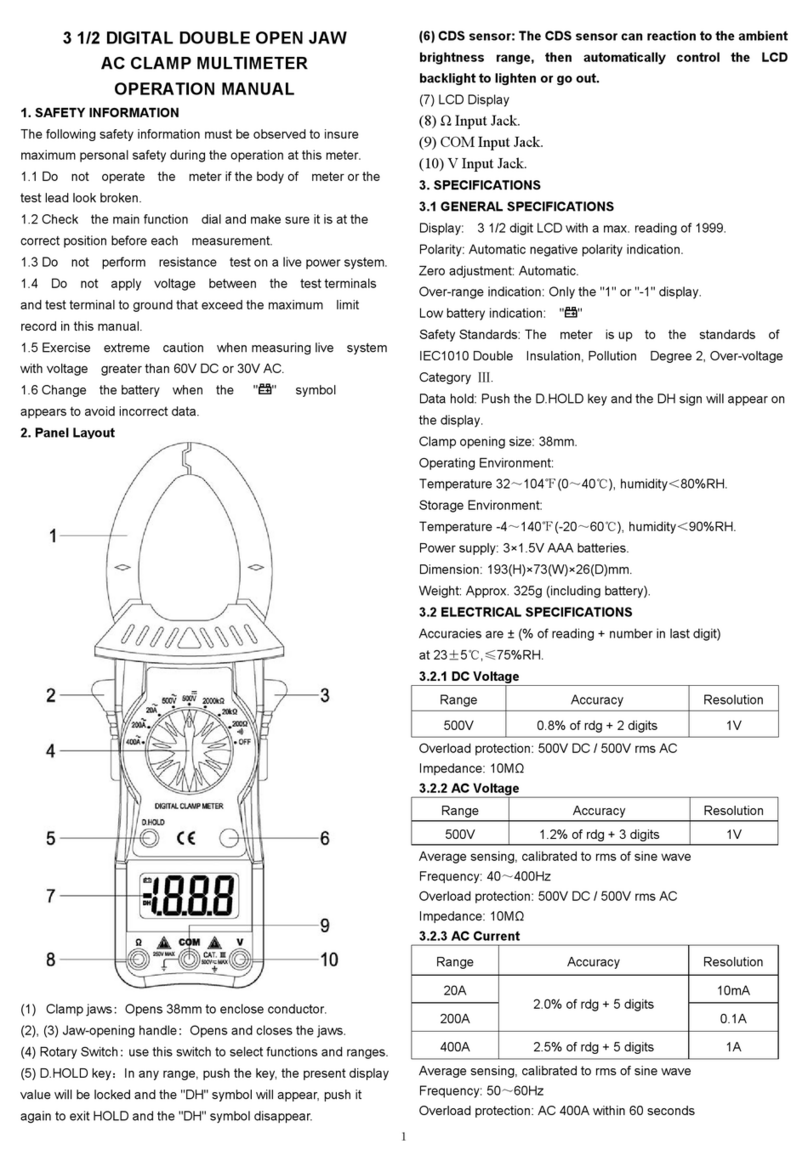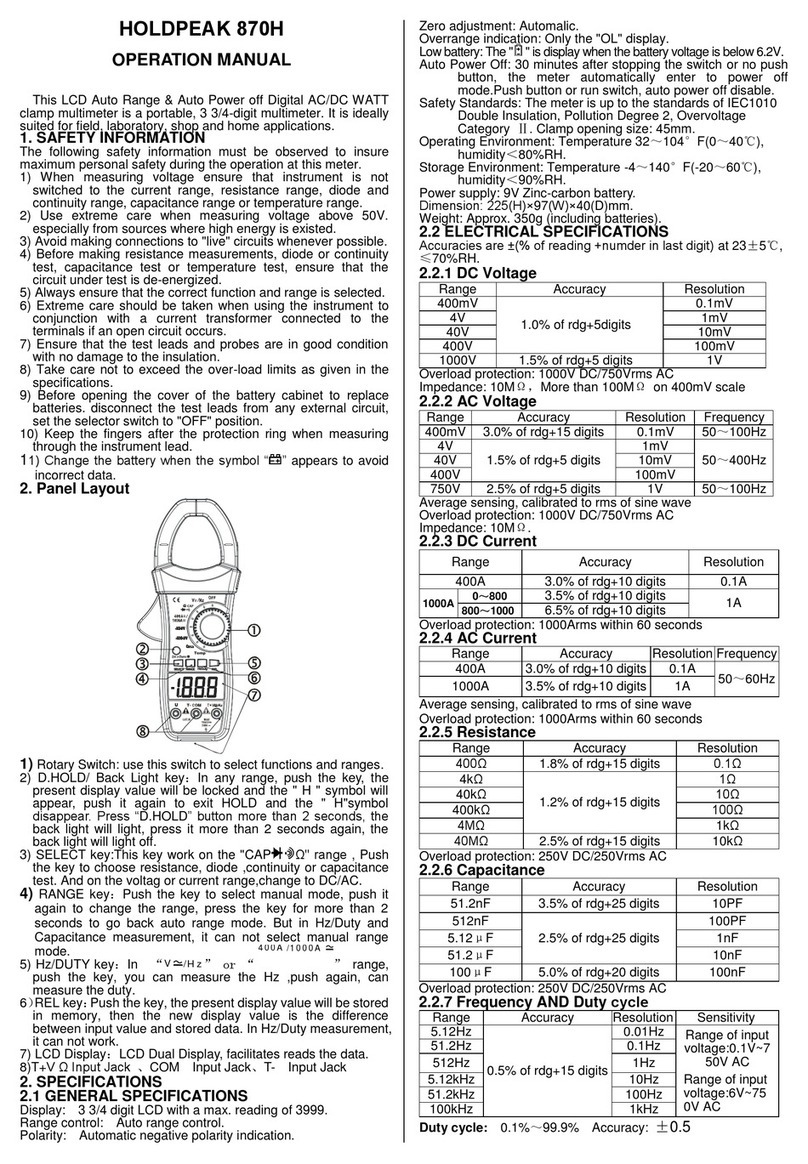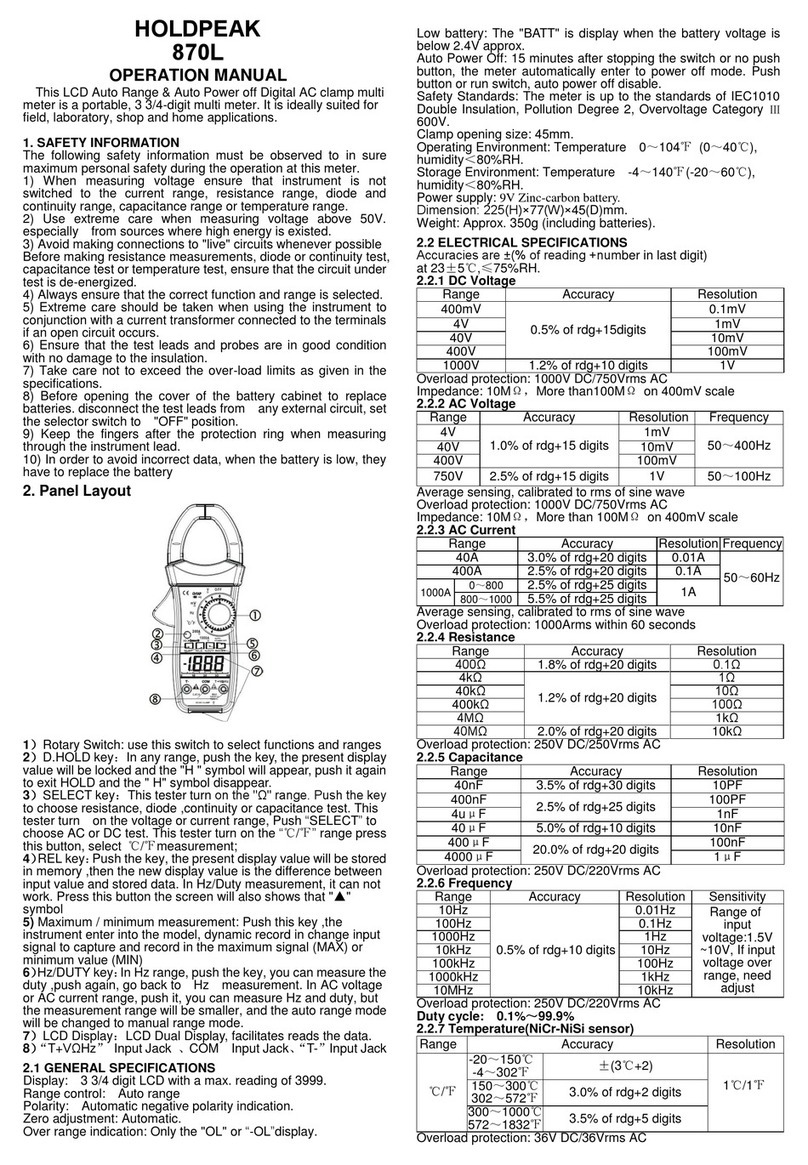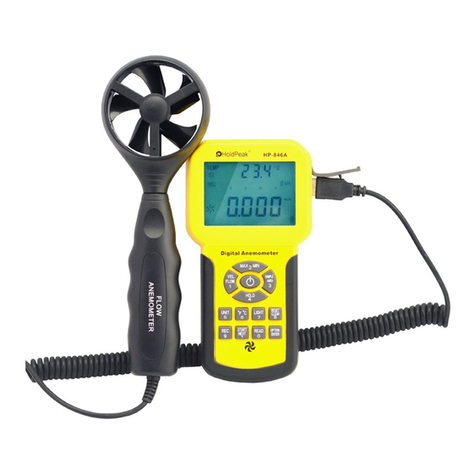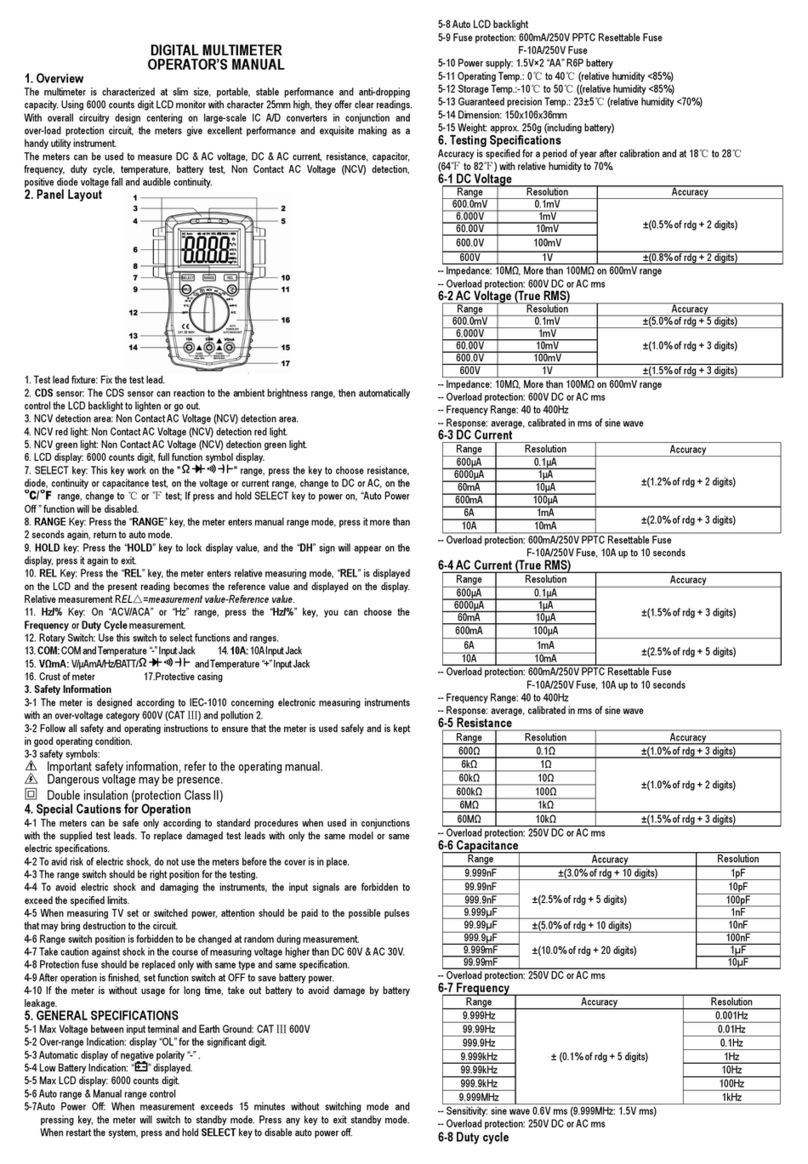
2.2.7 Frequency
Range of
input
voltage:1.5V
~10V, If input
voltage over
range, need
adjust
Overload protection: 250V DC/220Vrms AC
Duty cycle: 0.1%~99.9%
2.2.8 Temperature(NiCr-NiSi sensor)
Overload protection: 36V DC/36Vrms AC
2.2.9 Diode and Audible continuity test
Display read approx.
forward voltage of
diode
Forward DC current
approx. 0.4mA
Reversed DC voltage
approx. 2.7V
Built-in buzzer sounds if
resistance is less than
approx. 40Ω
Overload protection: 250V DC/250Vrms AC
3. MEASURING INSTRUCTION
3.1 DC/AV Voltage measurement
1) Connect the black test lead to "COM" socket and red test
lead to the "T+VΩHz" socket.
2) Set the selector switch to desired "mV" or "V" position .According
to need to press the "SELECT "button for AC/DC conversion
3) Read the result from the LCD panel.
3.2 AC/DC Current measurement
1) Set the selector switch to desired "200 “or "1000A " position,
According to need to press the "SELECT " button for AC/DC
conversion
2) Press the "REL" the display show "0" when test DC current.
Note:
As the jaw core may remain some magnetic force after using for
a while. If the display can not reach "0" When Press the "REL”,
please take following process to correct it:
A. To change the direction of the measured DC current.
B. Open the JAWS several times.
ACA test not to need the step
3) Open the clamp by pressing the jaw-opening handle and insert
the cable to be measured into the jaw.
4) Close the clamp and get the reading from the LCD panel.
5) Push the D.HOLD button to lock display value, pushitagain to exit.
6) Push the LIGHT button to light the back light.
Note:
Before this measurement, disconnect the test lead with the meter
for safety.
3.3Resistance measurement
1) Connect the black test lead to "COM" socket and red test
lead to the " T+VΩHz " socket.
2) Set the selector switch to desired "ΩCAP " position, the
present function is resistance measurement, if it is other function,
push the SELECT to select resistance measurement.
3) Connect the probes across circuit to be tested.
4) Read the result from the LCD panel.
Caution:
①Ensure that the circuit to be tested is "dead". Max. input
over-load: 250V rms<10sec;
②Don't allow in electricity loop of the online measurement,
measurement shall be first will loop before without electricity
3.5 Capacitance measurement
1) Connect the black test lead to "COM" socket and red test
lead to the " T+VΩHz " socket.
2) Set the selector switch to desired "ΩCAP " position.
According to "the SELECT" button can switch to the functionality
needed to yourself
3) Connect the probes to the capacitance to be tested.
4) Read the result from the LCD panel.
Caution:
a) Capacitors should be discharged before being tested.
b) This device adopts charging mode to measure capacitance, so
when testing large capacitance, it will take longer time before the
final indication, and the larger capacitor, the longer the time (For
4000uF range, it will take about 30 seconds).
c) When testing small capacitance, to assure the measurement
accuracy, first press "REL", then go on measuring.
Max. input over-load: 250V rms<10sec
3.6 Frequency/Duty measurement
1) Connect the black test lead to "COM" socket and red test
lead to the " T+VΩHz " socket.
2) Set the selector switch to desired "Hz" position.
3) Connect the probes to the point of measurement and read the
frequency from the display.
4) Push "Hz/DUTY", you can measure the duty. Press again, go
back to frequency measurement.
Max.input over-load: 250V rms<10sec
3.7 Diode test
1) Connect the black test lead to "COM" socket and red test
lead to the "T+VΩ" socket.
2) Set the selector switch to "ΩCAP " position. Push
"SELECT" to select diode test.
3) Connect the black and red test probe to the cathode (-) and
anode (+) ends of diode to be tested respectively, read the
forward voltage drop (junction) value from the display. If reverse
connected the probes to diode, display shows over-load.
Caution: Ensure that the circuit to be tested is "dead".
Max .input over-load: 250V rms<10sec
3.8 Audible continuity test
1) Connect the black test lead to "COM" socket and red test
lead to the " T+VΩHz " socket.
2) Set the selector switch to "ΩCAP " position.
3) Push "SELECT" to select audible continuity test.
4) Connect the probes across circuit to be tested, the beeper
sounds continuously if the resistance is less than approx. 40Ω.
Caution: Ensure that the circuit to be tested is "dead". Max .input
over-load: 250V rms<10sec
3.9 Temperature measurement
1) Connect the black test lead of the sensor to "T-" socket
and the red test lead to the " T+VΩHz " socket.
2) Set the selector switch to "℃/℉" position.
3) Put the sensor probe into the temperature field under
measurement.
4) Read the result from the LCD panel.
Max .input over-load: 250V rms<10sec
A. The temperature function must insert the thermocouple in
temperature test hole while examining temperature.
B. According to "the SELECT" button in the ℃and ℉to
switch between
C. This meter inclosure WRNM-010 type contact thermocouple
limit temperature is 250 ℃(300 ℃shortly ) ;
D. Please don't change the thermocouple at will , otherwise we
can't guarantee to measure accuracy ;
E. Please don’t importing the voltage in the temperature
function.
4. CARE AND MAINTENANCE
4.1 CARING FOR YOUR MULTIMETER
Your Digital Multi meter is an example of superior design and
craftsmanship. The following suggestions will help you care for
the multi meter so you can enjoy it for years.
1) Keep the multi meter dry. If it gets wet, wipe it dry immediately.
Liquids can contain minerals that can corrode electronic circuits.
2) Use and store the multi meter only in normal temperature
environments. Temperature extremes can shorten the life ofelectronic
devices, damage batteries and distort or melt plasticparts.
3) Please use this product carefully. Any dropping or damage
will lead to the circuit boards break or product unable working
normally
4) When take current measurement, keep the cable at the
center of the clamp will get more accurate test result.
5) Keep the multimeter away from dust and dirt, which can
cause premature wear of parts.
6) Wipe the multimeter with a damp cloth occasionally to keep it
looking new. Do not use harsh chemicals, cleaning solvents, or
strong detergents to clean the multimeter.
7) Use only fresh batteries of the required size and type. Always
remove old or weak batteries. They can leak chemicals that
destroy electronic circuits.
8) Please take out the battery when not using for a long time.
4.2 9Volt battery replacement
1) Ensure the instrument is not connected to any external circuit.
Set the selector switch to "OFF" position and remove the test
leads from the terminals.
2) Open the cover of the battery cabinet by a screwdriver.
3) Replace the old batteries with the same type batteries.
4) Close the battery cabinet cover and fasten the screw.
